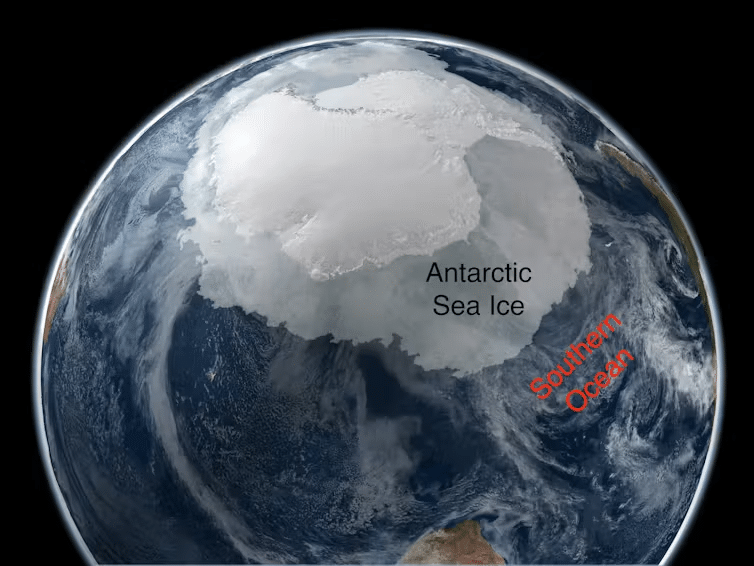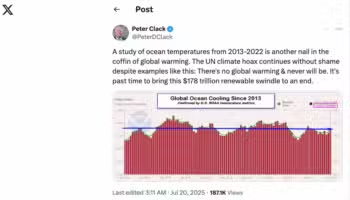- Climate
Study finds Southern Ocean’s surface is becoming saltier and losing sea ice, not experiencing an ‘ocean current reversal’
Key takeaway
Recent articles and social media posts inaccurately summarized findings from a June 2025 PNAS paper by claiming that a ‘major current in the Southern Ocean has reversed’. In reality, the PNAS paper does not mention any ‘ocean current reversal’. Instead, the paper mentions a ‘reversal’ of a decades-long trend: the Southern Ocean’s surface is now becoming saltier, instead of ‘fresher’. A saltier ocean surface can speed up the melting of Antarctic sea ice – floating ice which surrounds Antarctica – by drawing heat in the ocean upward toward the ice. This trend surprised scientists in the study, given that prior observations show the Southern Ocean’s surface becoming fresher (less salty) since the 1980s.
Reviewed content

Verdict:
Claim:
New study finds a major current in the Southern Ocean has reversed.
Verdict detail
Misrepresents source:
The June 2025 PNAS paper does not mention any ‘ocean current reversals’, but rather that a decades-long trend has reversed: the Southern Ocean’s surface is now becoming saltier, rather than ‘fresher’. As the Southern Ocean’s surface becomes saltier, it can speed up the melting of sea ice around Antarctica by drawing ocean heat upward.
Full Claim
A 2025 study finds that a major current in the Southern Ocean reversed for the first time in recorded history.
Review
In early July 2025, several social media users posted on X, claiming that there has been an ‘ocean current reversal’ in the Southern Ocean. One of these posts has already gathered over 1 million views.
So where did this bold claim originate? To investigate this, Science Feedback traced the claim online, which revealed that an inaccurate summary of a June 2025 research paper led to viral misinformation across social media and news articles. We also contacted one of the paper’s authors who helped clarify the findings.
Below, we will detail how this misinformation spread and explain the actual findings from a June 2025 PNAS paper which discusses not ocean currents, but salinity and declining sea ice in the Southern Ocean.
Study finds that the Southern Ocean’s surface is becoming saltier and sea ice is declining, surprising scientists
After reviewing the recent PNAS paper, Science Feedback found no mention of ‘ocean current reversals’.
Although some claims online generically refer to ‘deep ocean currents’, others mention a reversal of the Southern Ocean’s meridional overturning circulation (SMOC) or of the Deep Western Boundary Current (DWBC) – two entirely different ocean currents, neither of which are mentioned in the PNAS paper.
The paper itself is clear: it does not discuss ocean current reversals, but rising sea-surface salinity and declining sea ice in the Southern Ocean[1]. The authors do describe this as a ‘reversal’, but not of ‘ocean currents’. To confirm this, Science Feedback contacted one of the paper’s authors, Dr. Alessandro Silvano, Research Fellow at the University of Southampton, who explained:

Alessandro Silvano
Research Fellow, University of Southampton
“We do not discuss any currents in our recent work, but instead we focus on an unexpected increase in surface salinity in the Southern Ocean that occurred at the same time of rapid Antarctic sea ice retreat. I am not aware of any currents (e.g. AMOC or DWBC) reversing.”
In the PNAS paper, the ‘reversal’ refers to the Southern Ocean’s surface unexpectedly becoming saltier, after it had been becoming fresher (less salty) since the 1980s[2]. In the recent study, researchers used satellites to track sea surface salinity (SSS) – shown as the red line in Figure 1. Notice that around 2015 (black vertical dashed line), surface salinity began increasing and sea ice (black line) began retreating.

Silvano also offered a clear summary of their study’s findings in an article in The Conversation:
“What we found was astonishing. Around 2015, surface salinity in the Southern Ocean began rising sharply – just as sea ice extent started to crash. This reversal was completely unexpected. For decades, the surface had been getting fresher and colder, helping sea ice expand.”
Antarctica is mostly covered in ice sheets and is surrounded by sea ice (Figure 2). Sea ice both forms and melts entirely in the ocean, differentiating it from ice bergs which originally form on land but can later break off and float in the ocean. Because sea ice is always floating on top of ocean water, changes in that water’s characteristics affect the ice.

The ocean water beneath sea ice is not a uniform column of water, but one that is layered (or ‘stratified’) – meaning temperatures and salt content (or ‘salinity’) change with depth. The arrangement of these layers can also change over time, allowing sea ice melt more quickly, as Silvano explained in The Conversation article:
“To understand why this matters, it helps to think of the Southern Ocean as a series of layers. Normally, the cold, fresh surface water sits on top of warmer, saltier water deep below. This layering (or stratification, as scientists call it) traps heat in the ocean depths, keeping surface waters cool and helping sea ice to form.
Saltier water is denser and therefore heavier. So, when surface waters become saltier, they sink more readily, stirring the ocean’s layers and allowing heat from the deep to rise. This upward heat flux can melt sea ice from below, even during winter, making it harder for ice to reform. This vertical circulation also draws up more salt from deeper layers, reinforcing the cycle.”
Silvano then concludes that, to best anticipate and prepare for future climate change, scientists must update their models and conduct more continuous satellite surveys:
“Antarctica is no longer the stable, frozen continent we once believed it to be. It is changing rapidly, and in ways that current climate models didn’t foresee […] If we don’t update our scientific models, we risk being caught off guard by changes we could have prepared for.”
June 2025 research paper does not mention a ‘major ocean current reversal’ – here’s how that misconception spread
So how did misinterpretations of the PNAS paper start and spread?
The earliest mention of this claim Science Feedback could find was in a post that the Institut de Ciències del Mar (ICM-CSIC) – a marine research institute based in Barcelona, Spain – who contributed to the research published in the PNAS paper.
ICM-CSIC shared the post on X on 1 July 2025 – one day after the PNAS paper was published on 30 June 2025 – stating that the paper “unveils major reversal in ocean circulation in the Southern Ocean”. ICM-CSIC also appears to have made a variation of this claim in a newsletter, based on a screenshot an X user shared on 5 July 2025.
ICM-CSIC appears to have later noticed this error, as it was already corrected when Science Feedback accessed the same newsletter on 16 July 2025 (see archive). The newsletter title now reads: “A change in the Southern Ocean structure can have climate implications” – a different message entirely.
Unfortunately, the claim had already taken on a life of its own online, with different variations of it spreading on social media and news articles. For example, the claim was shared in an article from ‘bne Intellinews’ on 5 July 2025 titled “Southern Ocean current reverses for first time, signalling risk of climate system collapse”, which was then shared by users on X. The Guardian also shared this claim in a comic that says the SMOC has stopped or reversed.
Despite ICM-CSIC’s original intentions, the way this misinformation spread demonstrates the importance of accurate reporting when sharing information online.
Upon publication of this review, Science Feedback contacted bne Intellinews, The Guardian, and ICM-CSIC to make them aware of the respective inaccuracies in reporting and offered information for corrections.
References:
- 1 – Silvano et al. (2025) Rising surface salinity and declining sea ice: A new Southern Ocean state revealed by satellites. Proceedings of the National Academy of Sciences (PNAS).
- 2 – Haumann et al. (2016) Sea-ice transport driving Southern Ocean salinity and its recent trends. Nature.



